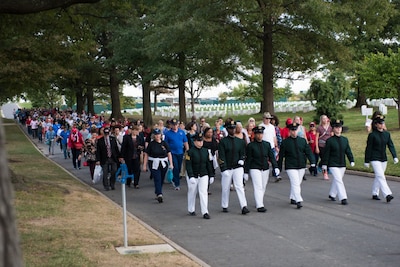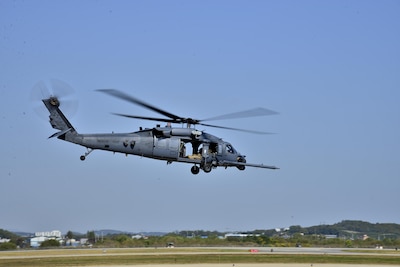By Air Force Staff Sgt. Kasey Phipps, Oklahoma Air National
Guard, 137th Special Operations
ARLINGTON NATIONAL CEMETERY, Va., Oct. 24, 2017 — Nearly 40
Oklahoma Air and Army National Guard women gathered here Oct. 21 with hundreds
of active duty, retired and reserve service members from all branches of the
military to celebrate the 20th anniversary of the dedication of the Women in
Military Service for America Memorial.
Honoring U.S. Military Women
The memorial honors all women who have defended America
throughout history. The gathering featured a weekend filled with remembrance,
honor, service, leadership, mentorship and inspiration.
“It just makes you reflect back on how much has changed in
these 20 years, and the sacrifices that women are still making,” said Army Col.
Cynthia Tinkham, the Oklahoma National Guard’s director of personnel. Tinkham
is one of five of the event attendees with the Oklahoma Guard who were present
at the memorial’s dedication 20 years ago.
The memorial here serves as a 4.2-acre ceremonial entrance
into Arlington National Cemetery. The memorial honors honor a very the nearly 3
million women who have served or are serving in or with the U.S. military since
the American Revolution.
The group arrived here Oct. 20, touring the memorial’s long
arching hall of memorabilia that covers the history of U.S. women in military
service.
“I’ve learned a lot about women’s history and the impact it
has on the Air Force and every other branch,” said Air Force Staff Sgt. Jaimie
Haase, a member of the Oklahoma Air National Guard.
WIMSA’s 20th Anniversary Ceremony
Major events throughout the weekend included a celebration
dinner, WIMSA’s 20th Anniversary ceremony, an honor walk and an after-dark
service of remembrance. Attendees ranged from women World War II veterans to
those currently serving in all branches of the U.S. military.
The keynote speaker of the morning’s ceremony, retired Air
Force Gen. Janet C. Wolfenbarger, who’s also the Defense Advisory Committee on
Women in Services chair, compared her experience at the dedication in 1997 to
the 20th anniversary ceremony this year, emphasizing that each year there are
more “firsts” to celebrate -- the first woman to serve in a particular branch,
in a particular career field and the first to die while serving.
“There are so many firsts that the memorial represents,”
Wolfenbarger said. “But, the real objective is that there are no more firsts.”
Air Force Brig. Gen. Thomas Ryan, the Oklahoma Air National
Guard’s assistant adjutant general, emphasized the importance of honoring the
past later that evening as Oklahoma Guard members and the other attendees held
candles honoring the lives of the 167 women who have fallen since the Sept. 11,
2001, terrorist attacks on the United States.
“We can never forget our history and those who have perished
for the sake of us all,” said Ryan, who was asked to speak at the event in
honor of the women killed in action.
‘Sacrifice is Meaningless Without Remembrance’
“Sacrifice is meaningless without remembrance,” he added.
Among the fallen was both the youngest and only woman in the
Oklahoma National Guard to die in combat, 19-year-old Army Spc. Sarina Butcher,
who was killed in 2011 in Afghanistan and is honored within the memorial.
“These women represent a bridge to those that came before
them,” said Tinkham who spoke on behalf of Oklahoma’s fallen women. “To those
of the new and current generation and to those still to join, I implore you to
keep telling their stories. Be proud of them. Honor them … and tell your own
stories.”









